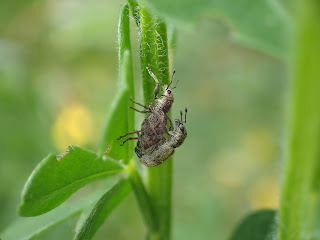Early July 2021
A couple of other interesting sightings from around Norwich. An emergence of flies in an old building is perhaps not unusual from time to time, but having seen a post online featuring something similar I realised that these particular flies were relatives of the soldierflies, and in an age with increasingly silly vernacular names being invented for books*, I was happy to find out they were called House Windowflies. The second species pictured here is a bug, Atractotomus mali, associated with Hawthorn or Apple.
* The logic of creating vernacular names is that learning the scientific ones puts people off learning groups of species that don't have vernacular names, and can thererfore make branches of natural history 'elitist' (although for this argument to be true, elite presumably means anyone who has taken time learning the names) and that people are more likely to care about things that they can name, which probably is probably true. There are however, some problems with this approach:
1) Personally I think the main thing discouraging people from learning about flies, beetles etc, is that there are thousands, many look very similar, no definitive field guide and many require dissection or microscopic analysis, rather than they have unfamiliar names
2) Quite a lot of these names are invented by one person (e.g. a field guide writer) and there is nothing to stop a different author also coming up with a completely different set of names, creating more confusion. Fungi is a notable exception, where a panel sat down together to come up with names for about 1000 species. Not all of the names are great, but at least they were agreed by consensus.
3) The best way of learning a new group is to go to events with experts and be shown things, yet most experts will have already learned the thousands of scientific names and are unlikely to be aware, or want to learn, thousands more made-up ones, that may or may not catch on. This actually risks creating a greater divide between the experienced and beginners.
Anyway, hobbyhorse stabled for now.












































